Q: What kind of repair was carried out in the Major Repair of the Inner Temple in the Heisei Period that was conducted from 2009 to 2010?
The inner temple (Kannon-do), which was destroyed due to the Great Tokyo Air Raid in 1945, was rebuilt in 1958. Since then, 50 years passed, and the temple was damaged all over. The temple was rebuilt of reinforced concrete in 1958 in order to cope with various issues, including prevention of fires, and traditional Japanese tiles were used for its roof. The Major Repair of the Inner Temple in the Heisei Period took a year and nine months to complete. The roof was reroofed, the walls were repainted, and seismic strengthening work were conducted. The 50-year-old tiles were damaged, and preparations for major earthquakes were needed, so titanium tiles were used. Since all tiles were replaced with titanium tiles, the weight of the roof is five times lighter than the one with traditional Japanese tiles. As a result of this work, the temple's structure can withstand a earthquake equivalent to the Great East Japan Earthquake. Although many people visited the temple when the earthquake occurred, they were all safe, so I was deeply grateful for the completion of this work.
Q: I heard that, compared to other buildings in the precincts, Rokkaku-do is very old.
Rokkaku-do is one of the oldest buildings in Senso-ji Temple, and is designated as a tangible cultural property in Tokyo. However, it is not known exactly when Rokkaku-do was built. It appears certain that it was built in a period between the late Muromachi and early Edo Periods. Aside from Rokkaku-do, Niten-mon is also old. It is said that the present gate was built in 1649. Niten-mon was designated as a nationally important cultural property in 1946. Although it was repaired and reinforced several times since its erection, it was totally repaired a few years ago by the country, Tokyo and Taito City, taking more than a year to complete. Many things could be found during the repair work. For example, the shape of the gate was significantly changed. As a result of consultation with the country, Tokyo and Taito City, it was decided to restore the gate to its original state in the early Edo Period as much as possible. (continued in the right column)
Q: Was Niten-mon originally painted vermilion?
It was painted vermilion. It is said that vermilion is a color to ward off evil spirits. Although vermilion on the gate partially came off, it was pained dazzling vermilion and restored to the original condition.
Q: What about temples related to Senso-ji Temple?
Senso-ji Temple was separated from the Tendai sect of Buddhism, and became a independent temple of the Sho-kannon sect in 1950. Now, there are a total of 25 temples in the one whole temple complex which consists of Senso-ji Temple, a head temple, and 24 branch temples, and there is another branch temple in Ningyo-cho. Although Senso-ji Temple is a Sho-kannon temple, it has been called "Asakusa Kannon-sama" and visited by a variety of people, regardless of their sects. Now, many foreigners also visit the temple.
Q: Aside from Rokkaku-do and Niten-mon, is there any historical building or site?
Denpo-in is also one of the historical buildings. Since the time when Ieyasu Tokugawa designated the temple as the Tokugawa family's prayer temple, the garden and buildings of Denpo-in were enlarged, however, "Senso-ji Nikki," a chronicle of Senso-ji Temple, says that Denpo-in was also burnt down due to the Great Fire of Meiwa in 1772, which occurred at Gyoninzaka in Meguro. Among the oldest buildings in the precincts are the grand entrance and the guest hall, which were rebuilt around 1777 after the great fire.
Denpo-in was designated as a National Place of Scenic Beauty in September 2011. The highly appreciated point was that Denpo-in's garden retained characteristics and shapes of gardens in the Edo Period. Although there are some famous gardens in Tokyo, those characteristics and shapes are rarely preserved in any gardens in temples, so Denpo-in's garden is considered to be very valuable. (continued in the lower left column)
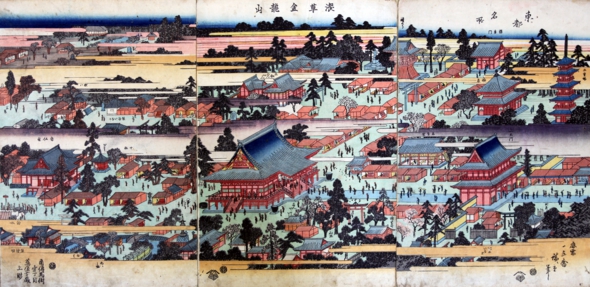
Overall View of Senso-ji Temple in Edo Period
Q: What kind of annual events are currently held in Senso-ji Temple?
There are a variety of events. The most bustling events are New Year's visit to the temple and "Siman Rokusen-nichi." Temple festival days vary depending on Buddhist images. A festival day for the Bodhisattva of Compassion is the 18th of each month, a festival day for the Guardian Deity of Travelers and Children is the 24th of each month, and a festival day for the God of Fire is the 28th of each month. The Bodhisattva of Compassion, or the principal image of Senso-ji Temple, manifested itself on March 18, so "Jigen-e," a Buddhist service, is held on the day, in which "Kinryu no Mai" is performed, praising the principal image's virtue. On June 18, "Yoji Josui Kaji-e," a ritual in which water purified by the principal image is poured over believers' heads, praying for their health, and "Hyakumi Kuyo-e," a ritual in which Hyakumi (candy) that substitutes for 100 kinds of delicacies of the sea and the land is offered with the daily gratitude to the principal image, are held. Also, on October 18, "Kiku Kuyo-kai," an event in which chrysanthemums are offered to the principal image, and believers received the offered chrysanthemums, is held. So a variety of events are held on the 18th of each month, that is, a temple festival day for the Bodhisattva of Compassion.
Q: What is the origins of "Kudoku-bi" and "Siman Rokusen-nichi”?
Aside from temple festival days, "Kudoku-bi," or a day on which believers can gain extra merit if they visit the temple, was set since the Muromachi Period. Especially on July 10, if believers visit the temple, they are supposed to gain merit equivalent to 46,000 days of visits to the temple. In short, "Kudoku-bi" is a faith recommendation day. In old times, people could not visit Senso-ji Temple and worshiped the principal image in a way present-day people do so. Therefore, people living in distant regions, who could visit the temple once a year or even once in a lifetime, were recommended to visit the temple on July 10 and gain the greatest merit.
46,000 days divided by 365 days, or a year, is approximately 126 years. It seems that people in the past thought of limits of human life-span as about 126 years. The day was set so that a lifetime's worth of visits to the temple was realized. That's July 10. However, if people left from distant regions on the morning of July 10, they could not arrive at the temple on July 10. Therefore, they left home on July 7 or 8, stayed at inns near the temple on July 9, and visited the temple at once when the temple's gate was opened on the morning of July 10. (continued in the middle right column)
Therefore, the area around the temple was crowded with many visitors also on July 9, so July 9 began to be regarded as the same "Kudoku-bi" as that of July 10. The two days, July 9 and 10, were considered to be "Siman Rokusen-nichi." That custom has continued to this day.
On the day of "Siman Rokusen-nichi," "Hozuki-ichi" is also held in the precincts. July 15 is the day of "Urabon-e." There is a custom in which, since a ground cherry looks like a votive light offered to the Buddhist image, ground cherries are offered as lights to a Buddhist altar on the day, so it seems that "Hozuki-ichi" was a good fair to buy ground cherries at this season. A ground cherry has also been used as a medicinal herb, so "Hozuki-ichi" at that time was crowded with many people who bought ground cherries. The bustle has continued to this day.
Q: Are there other events crowded with people?
A fair crowded with people at the end of the year is the battledore fair held on December 17, 18 and 19. December 18 is the last temple festival day of the year for the Bodhisattva of Compassion, so many people visit Senso-ji Temple. Looking at Ukiyo-e in which old-time year-end fairs are depicted, fairs selling items, such as decorations for the New Year, are widely held in the area stretching to the south of Asakusa-bashi and to the east of Ueno. It seems that people bought decorations for the New Year after they visited Sensoji Temple on the last days of the year. Nowadays, articles for the New Year can be bought at department store or convenience stores, so such large fairs are no longer held. However, among year-end fairs, only the battledore fair is still held. There is a custom in which a battledore is presented as a gift and talisman to a household where a baby daughter was born in the previous year. It is presented because a shuttlecock looks like a dragonfly, which eats harmful insects, meaning that the daughter is not pursued by bad men. It is a luck-bringer, so the battledore fair has been held to this day. Also, notable public figures, including sumo wrestlers, baseball players and entertainers, are depicted on recent battledores. I enjoy seeing those battledores.
Aside from the fair, many events are held in Senso-ji Temple. I think it is one of the reasons many people visit the temple.
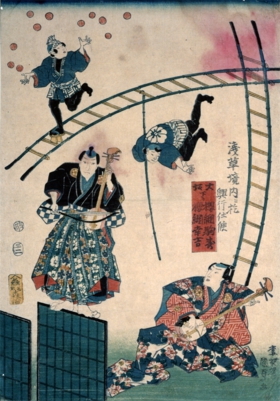
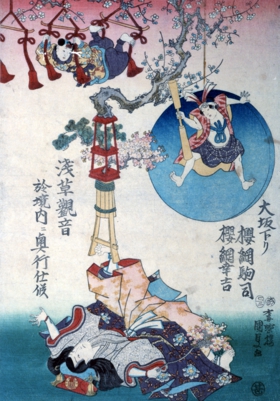
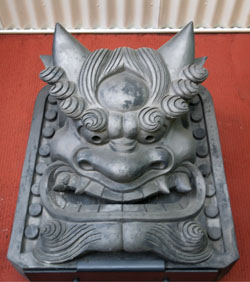
Ridge-end Tile of Senso-ji Temple
This ridge-end tile of Hozo-mon is exhibited at Asakusa Station on the Tokyo Metro Ginza Line. The tile was brought down when the roof tiles of Hozo-mon were repaired in 2007.
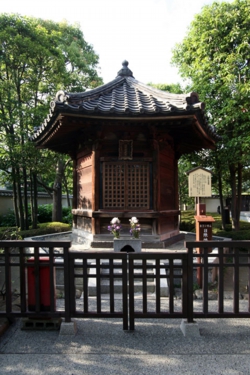
Rokkaku-do in Senso-ji Temple (a tangible cultural property designated by Tokyo)
It is considered that Rokkaku-do was built in a period between the late Muromachi and early Edo Periods. The single-story hexagonal building is built of wood, and has a tiled roof. It was originally located to the east of Senso-ji Temple, however, was moved to the present location near Yogo-do due to the development of the Senso-ji Temple precincts in 1994.

Ridge-end Tile of Senso-ji Temple
This ridge-end tile of Hozo-mon is exhibited at Asakusa Station on the Tokyo Metro Ginza Line. The tile was brought down when the roof tiles of Hozo-mon were repaired in 2007.

Rokkaku-do in Senso-ji Temple (a tangible cultural property designated by Tokyo)
It is considered that Rokkaku-do was built in a period between the late Muromachi and early Edo Periods. The single-story hexagonal building is built of wood, and has a tiled roof. It was originally located to the east of Senso-ji Temple, however, was moved to the present location near Yogo-do due to the development of the Senso-ji Temple precincts in 1994.








